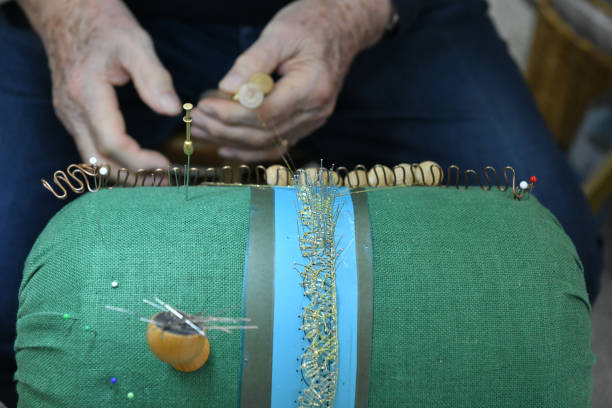
Albert Biggs was a Sydney-born laborer who joined the Australian Imperial Force as Alfred Briggs on August 22, 1915. He was 23 years old when he arrived at Gallipoli.
Biggs, who was part of the second reinforcements of the 20th battalion, fought to protect the Anzac’s trenches along the ridge called Russell’s Top. This is where the 3rd Light Horse Brigade launched their disastrous attack at the Battle of the Nek. In December 1915, his battalion evacuated to Egypt and was sent to the Western Front in April 1916.
Biggs received the Military Medal at Lagnicourt for his “great initiative” and “bravery” on April 15, 1917. However, he was seriously wounded in the second battle at Bullecourt on May 5. His left knee was permanently fused, and his right humerus was shattered by shrapnel. The nerves were so severely damaged that his left hand was barely usable.
Biggs spent almost 12 months in a hospital in Rouen before being transferred to Tooting Military Hospital, London. It was here that he first learned to embroider. In September 1918, he returned to Sydney and spent nearly two years in the 4th Australian General Hospital Randwick (now the Prince of Wales Hospital) and convalescent home. He was discharged in 1920.
Biggs is one of the more than 156,000 Australian men who were gassed, wounded, or taken as prisoners during the First World War. It is likely, like many of his comrades, that he also suffered from shell shock.
The hospitals that treated the wounded during the War and afterward provided bright, quiet, and clean environments in which the men could do meditative and transformative work essential for their recovery from physical and mental injuries.
This activity is called “fancy work”. The British, Australians, and New Zealanders who were wounded in World War I used embroidery as part of their therapy. This was wide, challenging the notion that it was “women’s work,” which was prevalent during the 19th Century.
The Australian War Memorial Museum, St Paul’s Cathedral in London, and the TePapa Museum in Wellington, New Zealand, are all places where soldiers have created beautiful embroidery.
From military heraldry to scenes of the French countryside and pieces for their sweethearts, the themes of the soldiers’ embroideries ranged from those.
The 4 AGH Randwick has a wide range of recreation facilities that can help soldiers with their rehabilitation and occupational therapy. The staff encouraged Biggs to continue embroidery as a way to pass the waiting time and improve his fine motor skills with his left hand.
Volunteers taught the classes at 4 AGH and, as Lieutenant Colonel CLS Mackintosh noted, helped the patients forget that they had any great disability. Volunteers led the classes at 4AGH, and as Lieutenant Colonel CLS MacKintosh stated, they helped patients “forget that they have any significant disability.”
At least four examples are on display at the Australian War Memorial. The first, completed at Randwick Hospital, is a cushion that has the 1912 Australian coat-of-arms sewn into stem, long and satin stitches onto a dark background.
We can infer from what we know of Biggs’s service that his choice of embroidery was a symbol of his consistency throughout his army experience. He was a worker before the War, but it turned him into a soldier, war hero, and invalid. But he was always Australian.
Biggs’ niece turned several pieces of Biggs embroidery into cushions. Six colorful embroidered butterflies adorn the back of the pillow. A Christian symbol for hope and resurrection, the butterfly’s three stages of existence are a Christian symbol. The butterfly is associated with Psalms 119:50: “This is comfort to me in my distress: for thy Word has quickened.”
Biggs created two other pieces: a piece that featured a king’s crown crossed Union flags and Australian ensigns within a laurel wreath. The work is topped with a scroll that reads, “For England, home and beauty.” Below it, a scroll says, “Australia will be there.” However, the rest of the pattern remains unfinished.
Biggs’ delicate work was an amazing achievement, as it would have taken years for him to learn. It is similar to a person who writes with their right hand learning how to do so again.
Their work created opportunities for economic growth. The Red Cross Hospital Handicrafts Shop, Sydney, sold their embroidery and ornaments. Visitors were encouraged to “purchase work from returned soldiers to assist them in helping themselves.” The Red Cross provided printed templates for embroidery. Many of these featured patriotic messages, like the piece Biggs did not finish.
The story of Biggs’s bravery at Gallipoli in France and 100 years later has been stitched to the larger “mythscape that surrounds Anzac Day. His embroidery speaks of the quiet dignity and courage of Australia’s soldiers who tried to rebuild their lives after World War I.
Two recent studies, both of which are interesting, have clarified the reasoning behind rehabilitation embroidery. One showed that everyday crafts are associated with emotional flourishing. This revealed the importance of handmade items to their makers. A study found that sewing and embroidery can help people work through the mental trauma of War.
The practice of rehabilitation embroidery is a new way to remember Biggs and the 416 809 Australians who served in WWI. We cannot forget the stories that they stitched in their needlepoint as we age.
